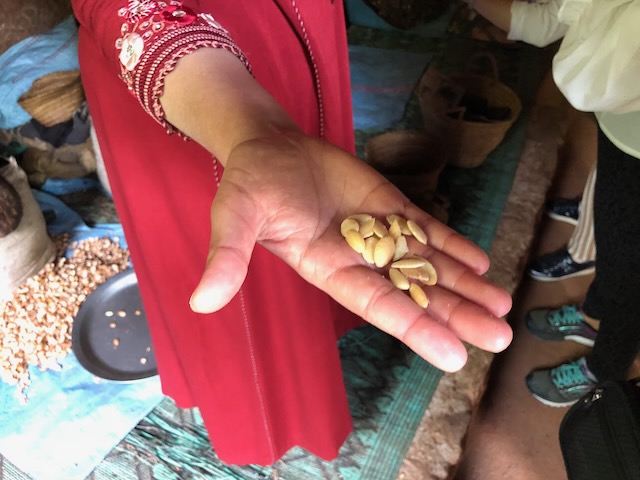Argan oil, derived from the nuts of the Argania spinosa tree, is one of Morocco’s most cherished natural resources. In the early 2000’s it was starting to be used in the global cosmetic industry, and in the 2010’s there were studies about the health benefits of Argan oil. All of this put severe pressure on the Berbers in Morocco and Algeria where all of the Argan trees are grown.
Before this time, Argan oil was produced strictly by hand, by mostly Berber women, and the paste and oil was used locally as both food and cosmetics. This was a very labor intensive method, with drying, roasting, shelling, and grinding done by hand. The women worked in cooperatives which produced small quantities of the paste and oil.
When you visit Morocco, you should make a visit to one of the Argan oil cooperatives. You will need a guide, as the workers seldom speak English. But here you will see first hand the impact of globalization – in this case the impact of the larger world discovering a product that they want and so the demand goes from a local business to a global one.

You can visit the cooperatives and farms located on the outskirts of the Marrakesh (a couple hour drive into the Atlas mountains). We drove out of Marrakesh and up the Ourika valley on the RP2017 road. At most of the Argan oil cooperatives along the way, you can observe the meticulous and manual-intensive process of oil extraction and learn about the socio-economic impact of this industry on the local community. The women are very passionate about their work – but it is being hugely disrupted. As the demand soared, first the employment increased. More and more women were giving up other labors to make money producing the oil. But then mechanization was implemented which reduced the labor necessary and lowering the price of the oil. By 2023, the price of oil produced by hand was $22 per liter, while the factories were producing it for $11 per liter. So not only were women being forced out of the labor market, their wages had downward pressures.

In these cooperatives, you will see the women who have been doing this for decades, using tools and processes centuries-old. Each nut is cracked and shelled individually by hand. Then depending on the end-use of the oil, the nuts are either left raw or roasted. For culinary purposes, the nuts are roasted before grinding, and often mixed with almond paste to create dipping sauces.
For use in cosmetics, the raw nut is ground into a very liquid paste. As can be seen in the video below, the grinding is slow and done by hand. The women take turns cracking, grinding and bottling the oil. In the cooperatives they also sell handmade food and cosmetics all based on their local production. This is where you can support the local economy by purchasing the oils, soap and sauces direct from the source. Yes the prices are higher than you’ll find on Amazon – but you can rest assured that the item is pure (not cut by other oils), and helps sustain the people, and have purchased something that has 1000’s of years of history.
Further up the RP2017 road, you pass several villages. We stopped at the Cafe Restaurant Hotel Asthma for lunch. While not much to look at, our guide assured us that the food would be well worth the visit.

Crossing the footbridge was interesting and not for the faint of heart. It wasn’t clear when it was last maintained?!? The restaurant itself was built around a large growing tree. It looks like the tree was originally outside of the building but as they expanded the building, it made “sense” to just build around it.

The food was very good – of course – it was various flavors of Tajine – (chicken, lamb, vegetarian). Maybe because it was cooked fresh for us, it was one of the better tajines that we had in Morocco.





We love finding these small, very local, restaurants far away from the crowded cities, away from the foreign tourist areas. I say foreign tourist areas because this valley we are in is the summer vacation spot for the locals – a way to escape the heat for a few days. They have a character that is unmatchable, each very unique. At Cafe Asma we sat on a covered patio, on the second floor of the building, overlooking the river. We could hear the running water and breathe in the fresh air. All while enjoying a perfect meal.
While in Morocco, also check out the Roman ruins at Volubilis.







